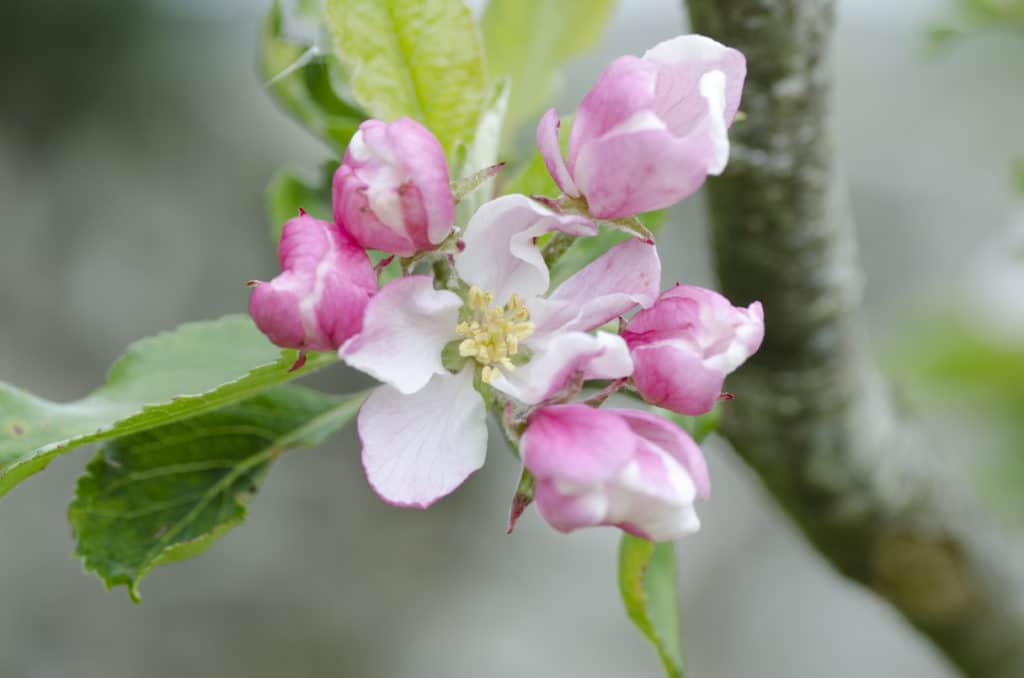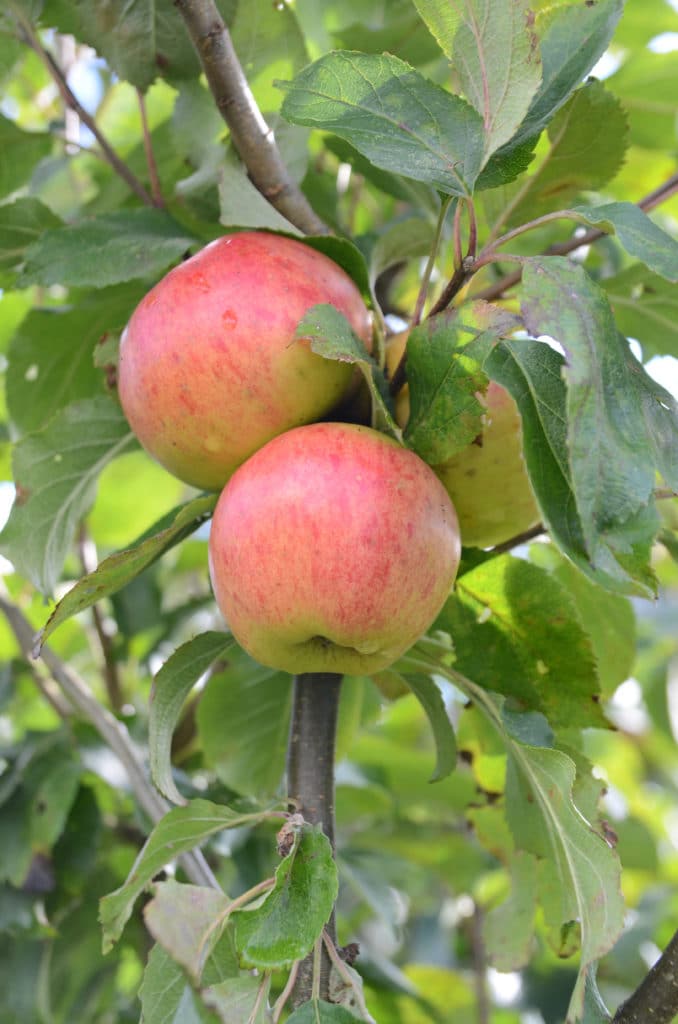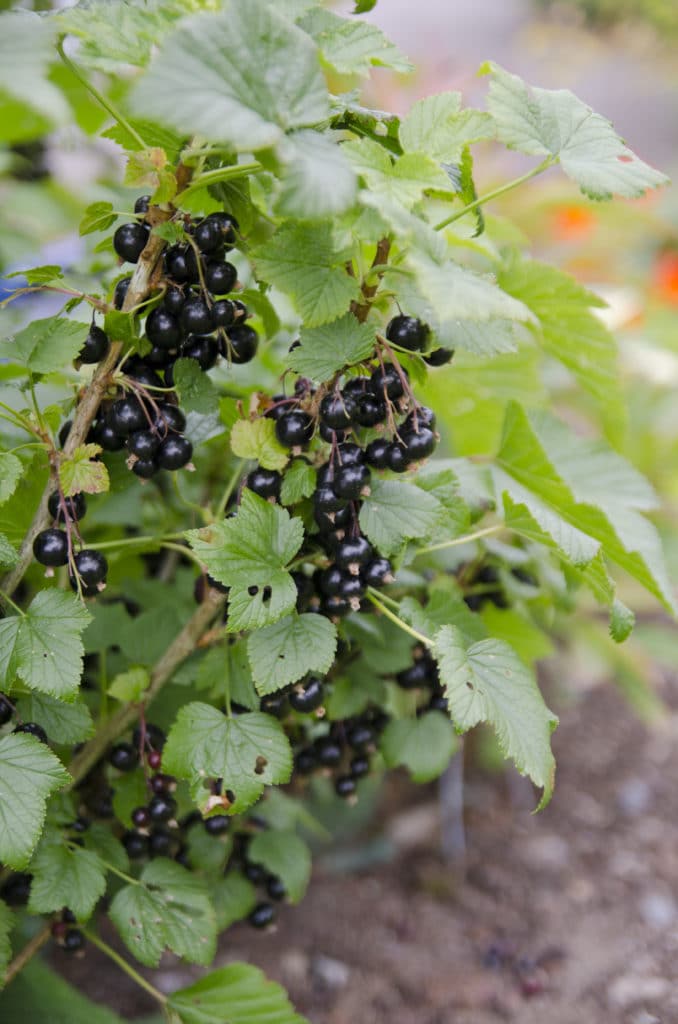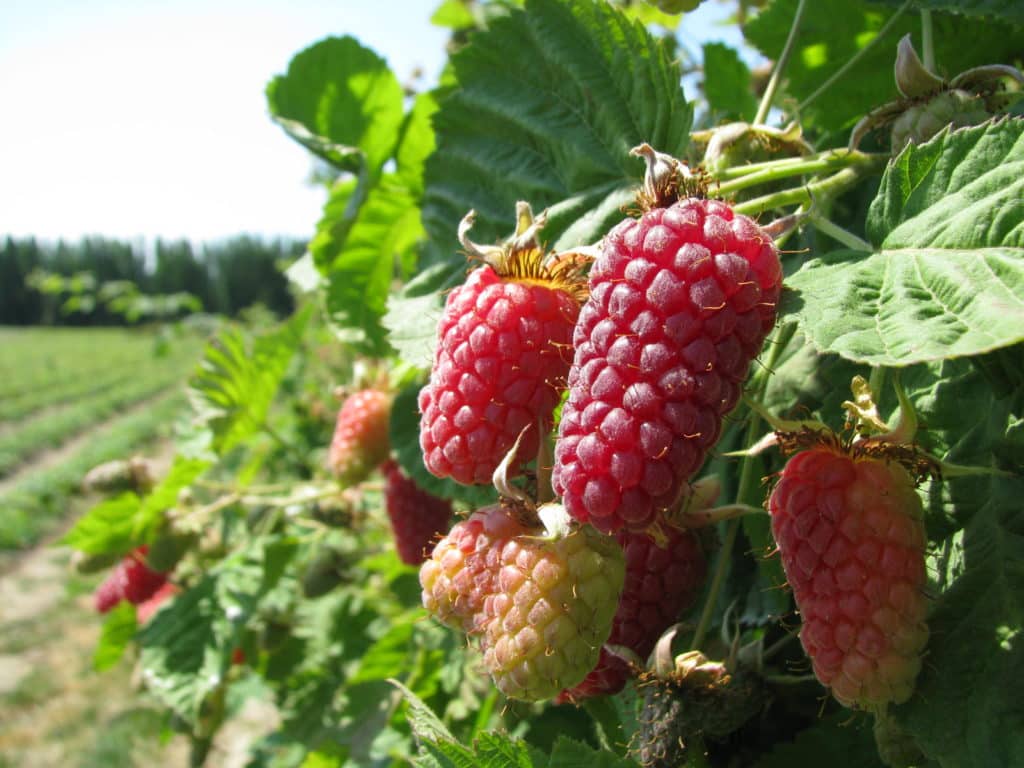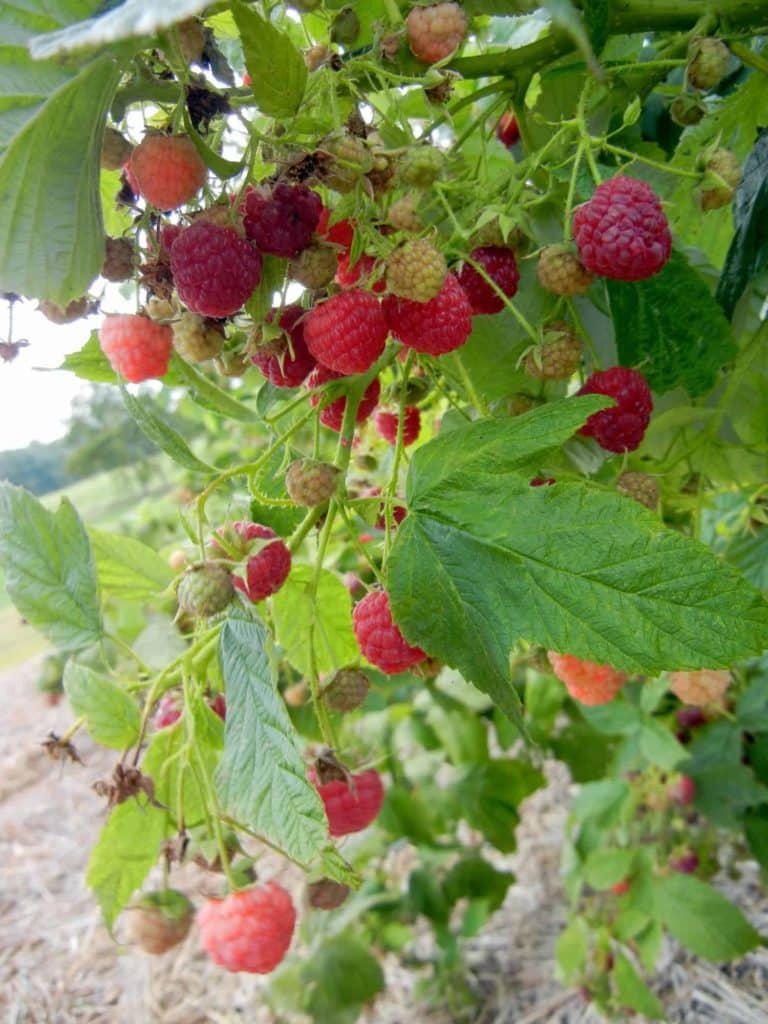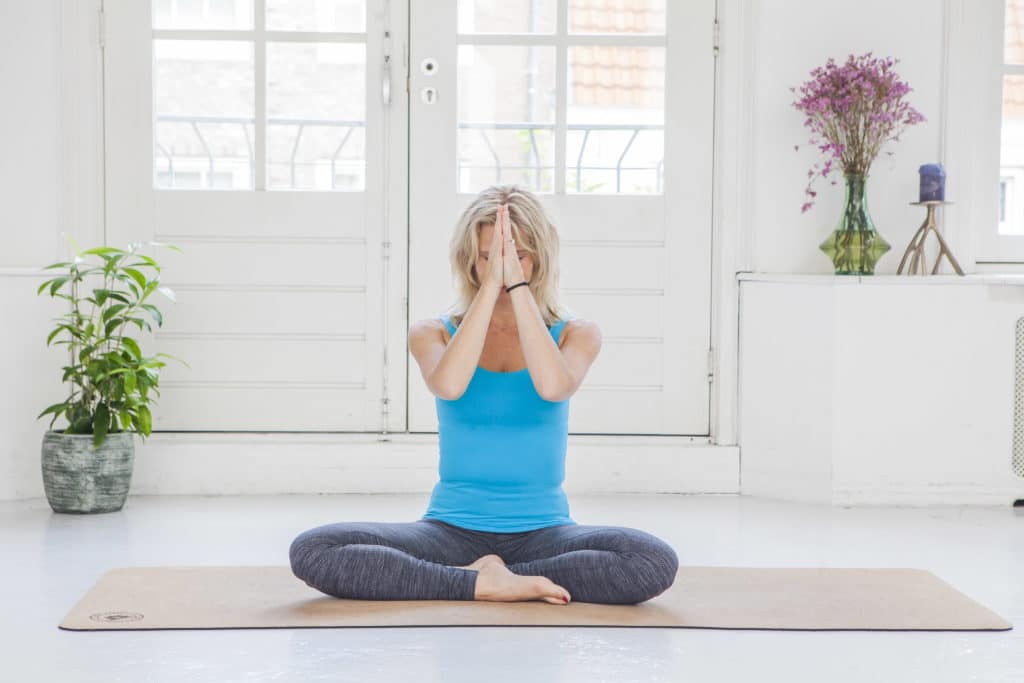Starting to grow fruit sounds daunting, but fruit-growing is less demanding than growing vegetables or annual flowers, and most soft fruit is really easy, as Deborah Ballard, Future Forests explains – especially now that so many of us have the time to work in the garden.
If you have the space for a couple of trees, fruit trees have two seasons of real beauty – in blossom and when the fruit is ripening – and make lovely specimen trees – you can plant spring bulbs underneath. Because fruit-trees are grown on rootstocks that control the size of the tree, there are ones for even the smallest garden, or even for a patio. Strawberries can be grown in the smallest bed or in pots. And nothing tastes as good as fruit from your own garden!
I’m going to give an outline of what you have to think about when starting to plant fruit, and from there, you can check out the various cultivars (named varieties) on the Future Forests website to find the cultivars that are right for you and your garden; you will also find there more information about rootstocks, onto which most tree-fruit is grafted. (When you plant your fruit-tree, be sure to leave the graft-union – the swollen-looking bit on the trunk where the cultivar is grafted onto the rootstock – a couple of inches above soil level).
When it comes to tree-fruit, beginners often worry about pruning, but it’s easier than you might think, especially at the important stage, when the tree is young. If it really spooks you, ask an experienced gardener to come and show you how.
To start with, think about your micro-climate and soil. Fruit generally prefers a deep, fertile, slightly acid to neutral soil, but most fruit will tolerate an alkaline or poor soil if plenty of organic matter – well-rotted manure or compost – is added to the soil. Also important is a reasonably sheltered site, and plenty of sun, although some fruit – gooseberries and sour cherries, for example – will tolerate some shade. Frost pockets should be avoided if possible, as a late frost can destroy the blossom.
TREE FRUIT
Apples
Apples usually do well in our climate, and there are several cultivars that cope with colder or wetter areas, and are resistant to scab, that curse of damp climates like ours.
Firstly, you will need two different cultivars, which must be compatible (i.e. that flower at more or less the same time), although one tree will probably be enough if close neighbours have apple-trees of their own. Note that Bramleys or other ‘triploid’ apples do not produce viable pollen, so if you live in an isolated spot you will need two different pollination partners, to pollinate the triploid apple and each other.
Apples come on dwarfing rootstocks, and will need to be staked for the first few years, and for life if on very dwarfing rootstocks (for a pot-grown patio tree, for example) – see the website for advice.
Check the vigour of the tree – a Sunset, say, will be two-thirds the size of a Bramley when grown on the same rootstock. Look for a cultivar which is compact and not lanky – they’re easier to prune (and harvest).
Choose a hardy, healthy cultivar: You need a canker- and scab-resistant cultivar in most parts of Ireland, and a cold- and wet-resistant one except in very mild areas.
Apples bear their fruit on little ‘spurs’ growing from the branches, or at the tips of the branches, or on both (a ‘partial tip-bearer’). Choose a spur-bearer – they’re easier to prune (and can also be trained if you’d like to give it a try). Choose a reliable cropper, which is not prone to biennial bearing if not ruthlessly thinned.
Don’t choose an early apple unless you’re planting several apple-trees. Early apples only keep for a week after ripening, although the ones on the shady side of the tree ripen later, and leftovers can be juiced and frozen. Look for a mid-season apple, which will ripen in September and keep until December, or a late one, which you pick in late October and will keep well into the new year, sometimes as late as March, if stored properly in cold but frost-free conditions.
If you only room for one tree, consider planting a dual-purpose apple, for eating and cooking. These slowly sweeten in store for eating, and generally keep their shape well when cooked, instead of dissolving into a purée.
Finally, choose one with the RHS Award of Garden Merit. There are many other excellent apples, but an AGM tree will usually be best for beginners.
For most Irish conditions, I’d recommend Sunset and Egremont Russet (mid-season eaters), Winston and Winter Gem (late eaters), Charles Ross (lime-tolerant) as a dual-purpose apple, and Lane’s Prince Albert as a cooker. If you have room for an early apple, Katy is very good. But of course, there are hundreds of other really good apples out there, so do browse the website and pick the one that suits you.
Pears, plums, greengages, damsons and cherries
Pears, plums and cherries need warmer, sunnier conditions than apples to fruit well and they come into blossom earlier, so can succumb to frost in colder areas. Choose a late-flowering cultivar if your garden is prone to late frosts. They will often fruit much better if trained as a fan (pears, cherries and plums) or as an espalier (pears) against a warm, south-facing, sheltered wall – but that’s a bit daunting for beginners! They, too, generally need compatible pollination partners, but there are self-fertile or partially self-fertile cultivars if you haven’t room for two.
Pears:
Pears are mostly spur-bearers, and form spurs very readily, although there are a few tip-bearers. Most need a pollination partner, and there are a few triploid varieties, which should be avoided unless you’re planting an orchard (see under Apples for explanations). If your garden is prone to late frosts, choose a pear in Pollination Group 5, like Beth.
Pears tend to have a very upright habit, but it’s really easy to keep pruning to an outward facing bud when the tree is young, to encourage a more goblet-like shape.
Pears are picked when they’re fat but still hard – check the picking time on the website – and ripened indoors; they don’t store well
If you want to try growing a single, free-standing pear-tree in less than perfect conditions, Conference is the one to go for, as it can produce seedless pears without being pollinated, is reliable, and is very well adapted to the Irish climate. If you have room for two, choose a hardy, compatible one – Concorde is very good, being compact, reliable and early into bearing, with a delicious flavour.
Plums, Greengages, Myrobalans and Damsons:
Like pears, plums, greengages, myrobalans (cherry plums) and damsons bloom early, so a warm site is preferable; choose a late-flowering cultivar (pollination group 5), like Blue Tit, if your garden gets late frosts. They like a deep, fertile, clay soil, just on the acid side of neutral. Many plums are at least partially self-fertile, but all will fruit better with a pollination partner; fortunately, all these cousins fertilise each other if they bloom more or less at the same time. Plums must only be pruned in summer, as they are prone to silver-leaf disease if pruned in autumn or winter.
Fresh plums do not keep, but cooked plums, frozen, will see you through the winter, so do consider cooking plums like Czar or Rivers’ Early Prolific; both can also be eaten fresh when fully ripe.
An old, popular plum that does well in our climate is Victoria, perhaps better eaten cooked than fresh; Opal is quite hardy, too, and has a better flavour for eating fresh. Both come into flower mid-season; the culinary plum Yellow Pershore flowers a little later.
Luscious greengages need even warmer conditions to fruit well than most plums, and are unlikely to fruit well except in the warmest areas.
Myrobalans (cherry plums) are smaller and tougher, and damsons are super-hardy and disease-resistant, and will grow anywhere, often producing so much fruit that it can break the branches if the fruit is not ruthlessly thinned. Some damsons, like Farleigh (very good in colder, wetter areas), are sweet enough to eat fresh in a good summer, and all are wonderful for pies and jam. A lovely way to grow myrobalans and smaller damsons and their cousin the bullace is to grow them as part of a fruiting hedge.
Cherries
Sweet cherries make quite big trees, and have spectacular blossom. They make lovely specimen trees, the only disadvantage being that the birds are likely to take all the fruit before it’s ripe enough for you. If you want fruit, it’s better to train them against a warm wall. Cherries are quite tolerant as to soil, as long as it’s well-drained and fairly deep. They must only be pruned in summer.
Most cherries need a pollination partner, but if you only have room for one, the delicious sweet cherry Stella is self-fertile; Sunburst is partially self-fertile, although it may crop better with a pollination partner. Like plums, cherries don’t keep, so do consider a culinary cherry like Morello, the delicious, sour cooking cherry, for pies, bottling and Black Forest gateau; it’s small, partially self-fertile, and shade-tolerant, a great pollinator for other cherries, and birds aren’t so keen on the fruit.
FRUIT BUSHES
Blackcurrants, gooseberries, redcurrants, white currants and blueberries are easy to grow, making 5’x5’ bushes, sometimes smaller. There also interesting hybrids, like Jostaberries and Worcesterberries. They prefer reasonably fertile, well-drained soil, just on the acid side of neutral, and a sunny position, although thorny gooseberries will grow practically anywhere and will tolerate some shade. They are self-fertile, so even small gardens can have room for one bush.
Blueberries must have sunshine and a decidedly acidic soil – neutral will not do – but they grow well in ericaceous soil-based compost in large pots. They have pretty little white flowers, and most have glorious autumn colour. They fruit over quite a long period, and fruit best if you grow two different varieties – choose an early and a mid-season variety, like Goldtraube (early, and well-adapted to our climate) or Patriot (early) and Bluecrop (mid-season). Blueberries are easily pruned, by taking out crossing branches, and occasionally removing an old stem to the base.
The easiest to prune are blackcurrants; simply cut one-quarter to one-third of the stems to the ground every year, choosing the oldest (darkest) stems to prune out. Cut out any crossing or damaged branches at the same time. Plant them deeply, to encourage new stems at the base.
Tart blackcurrants are used for cordials, jams and juices, and are very good for you; one bush is usually enough. The ‘Ben’ cultivars, particularly Ben Tirran, are best for colder areas.
Red and white currants and gooseberries are best grown on a ‘leg’ – a little trunk about 4” high – and need their main branches cut back by a third of the new growth each year, as well as removing crossing and damaged branches and any growth from the ‘leg’. Gooseberries need to be kept very open to deter sawfly and American gooseberry mildew, so additionally cut back the laterals (side branches) to three buds. Choose a gooseberry with upright, rather than drooping, growth – it’s easier to manage.
Redcurrants are extremely attractive, and quite tart, and are wonderful with strawberries. Jonkheer van Tets has an excellent flavour, while Rovada is good for small gardens and colder areas. White currants are also beautiful, and sweeter; White Versailles has a very good flavour, and Blanka is a very heavy cropper. All will need netting, as birds love them (you may have to rescue determined birds from the nets).
Gooseberries are as tough as old boots; some, like Hinnonmaki Red (good in colder areas) can be eaten fresh when fully ripe, and all can be made into jams, pies and crumbles when under-ripe. The cooking gooseberry Invicta is very reliable, and Black Velvet is immune to American gooseberry mildew.
Consider cold-hardy honeyberries, too, although you have to grow two different varieties for them to set fruit.
Strawberries
Everyone loves a strawberry – it’s the taste of summer. They are easy to grow in beds, and can even be grown in pots and hanging baskets. After a cold spell outside, potted strawberries can be brought into a polytunnel or greenhouse for an extra-early crop.
Strawberries like fertile garden soil, and remain productive for about three years, although Cambridge Favourite (mid-season) goes on for up to six years. Bare-root runners can be planted in September. As the fruit develops, support it on a mulch of straw (hence the name) or on more modern strawberry mats, to keep it off the soil and prevent rotting and slug attack. Always net your strawberries as they begin to ripen, or birds will take the lot.
In summer, strawberries produce runners, tiny new plants on long stems. Allow only one little plant to root, and cut the rest of the runner away, to preserve vigour in the original plant; you can start a new bed with the new plants, so you never go short of delicious strawberries. If you leave them where they are, the old bed will get matted and weedy, but will still produce strawberries.
Summer-bearing strawberries produce big crops over a few weeks in mid-summer, with early, mid-season and late varieties. Honeoye is a good early, Cambridge Favourite and the popular commercial variety Elsanta (much more delicious home-grown) are great mid-season strawberries, and late-season Symphony is particularly adapted to colder or damper areas.
There are also ‘perpetual’ strawberries, like Ostara, which produces two smaller crops, or Mara des Bois, which tastes like an alpine strawberry. Alpine strawberries, like Alexandria, don’t produce runners and make pretty edging plants; the fruit is small, delicious and not very juicy, making a beautiful, scented garnish for cakes, puddings and fruit salads.
It’s also worth trying the Framberry, a raspberry-flavoured strawberry, and the aromatic white strawberry Snow White, with pink pips, which is less attractive to birds.
CANE FRUITS
Cane fruits include raspberries (summer- and autumn-fruiting), blackberries, the Japanese wineberry and hybrid berries like tayberries and sharper-flavoured loganberries (best for preserving and cooking). All are absolutely delicious, and raspberries in particular freeze exceptionally well.
All these, ‘apart’ from autumn-fruiting raspberries – much the easiest for a beginner – need training up wires strung between posts or along a sunny wall. The fruit is borne on second year canes, which are pruned out after fruiting, after which the new growth is tied in, to provide fruit for the following year. Raspberries and pretty Japanese wineberries are a reasonable size (5-8’); the others can grow very large. If you have a very small garden, you can plant three raspberry canes round a single post, or even singly in a pot (choose a small cultivar like the excellent Malling Jewel.
Cane fruits particularly raspberries, prefer a soil slightly more acid than neutral, but most will cope with any reasonably well-drained soil. They have to be netted, or birds will get the lot.
Look out for the thornless blackberries Merton Thornless and Loch Ness, and the unusual white blackberry Polar Berry. Raspberry-fanatics will grow early, mid-season and late varieties – try Glen Moy (early) Malling Jewel (mid-season) and Glen Ample or Leo (late). Tayberries ripen over a long period.
Autumn-fruiting raspberries
Autumn-fruiting raspberries don’t grow too tall and fruit on first-year wood, which makes them super-easy; they come up in spring, fruit that year, and are then cut to the ground in late winter. You may have to wait until late summer and autumn (August until the first frosts) for your raspberries, but by that time, the birds will have lost interest, or at any rate leave enough for you, so they rarely need netting. Two good varieties are Autumn Bliss and, if you like a yellow raspberry, All (or Fall) Gold. Eat them fresh, or make them into the most delicious jam – a wonderful smell in the autumn kitchen.
A useful trick is to leave some of the canes of autumn raspberries uncut; they fruit in summer the following year, so you can have some raspberries in summer; cut these canes back after fruiting.
Like their summer-fruiting brethren, autumn-fruiting raspberries are ‘divils’ for running at the root; dig unwanted ‘spawn’ out pronto, or sink 8” planks round the bed.
To see all the fruit that Future Forests offer, see www.futureforests.ie or for more information or call 027 66176.


